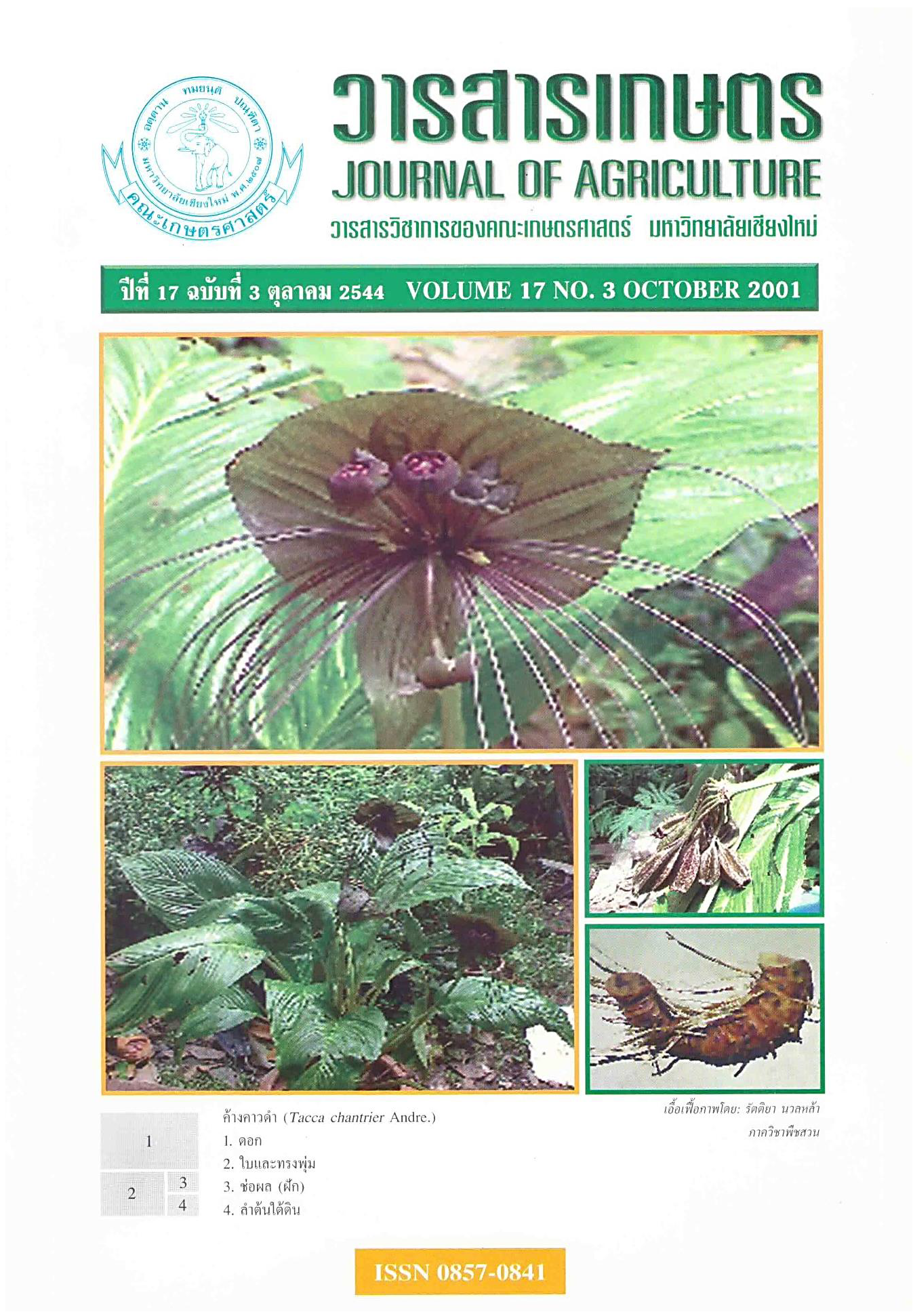คุณภาพโปรตีนและค่าพลังงานใช้ประโยชน์ของกากทานตะวันและกากเรปซีด
Main Article Content
บทคัดย่อ
จากการศึกษาค่าการย่อยได้ที่แท้จริง โดยใช้พ่อไก่ที่ทำท่อมูลเทียมและพ่อไก่ปกติอย่างละ 4 ตัวพบว่า การย่อยได้ที่แท้จริงของโภชนะส่วนใหญ่ (วัตถุแห้ง โปรตีน ไขมัน NFEและอินทรีย์วัตถุ) ในกากถั่วเหลืองสูงกว่า กากทานตะวัน และกากเรปซีดอย่างมีนัยสำคัญ ไก่ที่ทำท่อมูลเทียมมีค่าการย่อยได้ของวัตถุแห้ง โปรตีน NFE และอินทรีย์วัตถุถูกต้องกว่าและสูงกว่าค่าที่ได้จากไก่ปกติ แต่มีค่าการย่อยได้ของเยื่อใยต่ำกว่า ส่วนค่าการย่อยได้ของไขมันไม่แตกต่างกัน
ในแง่ของพลังงาน พบว่า พลังงานย่อยได้จริง (TDE) มีค่าสูงกว่าแบบปรากฏ (ADE) และพลังงานใช้ประโยชน์แบบจริง (TME) ก็มีค่าสูงกว่าแบบปรากฏ (AME) ทั้งในไก่ปกติและไก่ที่ทำท่อมูลเทียม โดยชนิด ของไก่ให้ค่าพลังงานไม่แตกต่างกัน แต่ต่างกันที่ชนิดของวัตถุดิบ คือกากถั่วเหลืองมีค่าสูงกว่ากากทานตะวัน และกากเรปซีดอย่างมีนัยสำคัญ (TME เท่ากับ 3.7 vs. 2.8 และ 2.2 kcal/g DM, ตามลำดับ)
จากการประเมินคุณภาพโปรตีนของกากทานตะวันและกากรปซีด โดยใช้ลูกไก่เนื้อ อายุ 7 วัน จำนวน 80 ตัว และหนูขาวอายุ 3 สัปดาห์ จำนวน 20 ตัว แบ่งออกเป็น 4 กลุ่มตามสูตรอาหาร (รวมทั้งสูตรเคซีนและสูตรที่ปราศจากไนโตรเจนด้วย) พบว่า กากเรปซีดและกากทานตะวันมีคุณภาพโปรตีนไม่ต่างกัน โดยมีค่าประสิทธิภาพการใช้โปรตีน (PER) เท่ากับ 1.4 และ 1.0 และ NPR เท่ากับ 2.9 และ 2.9 การใช้ไก่เป็นสัตว์ทดลองได้ค่าดังกล่าวสูงกว่าเมื่อใช้หนูอย่างมีนัยสำคัญ (PER = 1.5 vs. 0.9 และ NPR = 3.4 vs. 2.3, ตามลำดับ)
Article Details
เอกสารอ้างอิง
วีระศักดิ์ สามารถ, สุชน ตั้งทวีวิพัฒน์ และบุญล้อม ชีวะอิสระกุล. 2542. การหาค่าการย่อยได้และ พลังงานใช้ประโยชน์ของกากทานตะวันในไก่ที่ทำท่อมูลเทียมและไก่ปกติ. ใน: รายงานการประชุมทางวิชาการ ครั้งที่ 37 สาขาสัตว์, หน้า 68-75, มหาวิทยาลัยเกษตรศาสตร์, กรุงเทพฯ
A.0.A.C. 1990. Official Methods of Analysis, 15th ed., Association of Official Analytical Chemists, Washington, D.C., USA.
Clandinin, D.R. and A.R. Robblee. 1950. The effects of methods of processing on the nutritional value of sunflower meal. Poultry Science, 29: 753.
Dale, N. 1997. Ingredient analysis table : 1997 edition. Feedstuffs Reference Issue, 69(30): 24-31.
Dalibard, P. and E. Paillard. 1995. Use of the digestibility amino acid concept in formulating diets for poultry. Animal Feed Science and Technology, 53(2):189-204.
Fuller M.F. 1988. Methods of protein evaluation for nonruminants. In: Feed Science. pp. 81-101.1st ed., E.R. Orskov,Rowerr Research Institute Greenburn Road, Buckburn, Aberdeen AB2 9SB, Scotland.
Green, S. and T. Kiener. 1989. Digestibilities of nitrogen and amino acids in soya-bean, sunflower, meat and rapeseed meals measured with pig and poultry. Animal Production, 89(1):157-179.
Lee, K.H., G.H.Qi and J.S. Sim. 1995. Metabolizable energy and amino acid availability of full-fat seeds, meal and oils of flax and canola. Poultry Science, 74(8):1341-1348.
NRC (National Research Council). 1994. Nutrient Requirements of Poultry, 9th ed., National Academy Press, Washington, D.C. USA.
Rad, F.H. and K. Keshavarz. 1976. Evaluation of nutritional value of sunflower meal and possibility of substitution of sunflower meal for soybean meal in poultry diets. Poultry Science, 55(5):1757-1765.
Sibbald, I.R. 1977(a). The true metabolizable energy system. Part I: Advantages of T.M.E in poultry feed formulation. Feedstuffs, 49(42):21-22.
Sibbald, I.R. 1977(b). The true metabolizable energy system. Part II: Feedstuffs value and convention data. Feedstuffs, 49(43):23-24.
Zhang, Y. and C.M. Parsons. 1994. Effect of overprocessing on the nutritional quality of sunflower meal. Poultry Science, 73(3):436-442.


